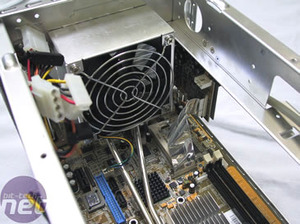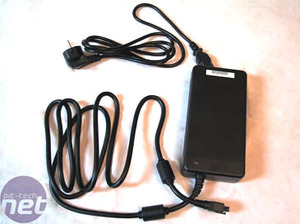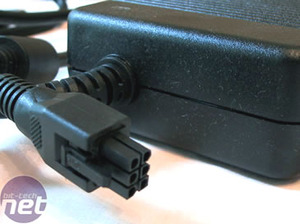
ICE Cold...
The classic ICE unit of XPCs this time sports a small CPU block and a pair of exceptionally long heatpipes, because the CPU socket is right at the front of the case. This doesn't matter though, due to the low heat output of the Pentium M CPUs. In contrast, the ST20G5 has a much larger CPU block and four heatpipes to the same 92mm fan. The fan is of the 4-pin variety and is controlled by PWM in the BIOS to provide anywhere between a strong but noisy airflow, to weak airflow with near silent operation.

Absolute Power
If you want any clue as to how big the Xbox 360 power supply will be, the one provided with the Shuttle SD11G5 XPC should give you a good idea. Describing it as a brick barely does it justice. At 220W it's as beastly as the internal power supplies we have seen in other XPCs, yet is completely fan-less. You get a lead that is a reasonable length, so you can hide the power brick (for want of a better word) under your desk and out the way.In our opinion, this has been a long time coming and something the XPC range could do benefit from with other models. Indeed, Shuttle told us they have been developing an external PSU as far back as the SN85G4. For those who are not familiar with that chassis, it is from back in the early Athlon 64 days when NForce 3 150 ruled the rooster. Finally, it seems they've cracked it.


The internal PSUs kick out a lot of heat, adding to the oven effect that is often suffered by XPC users, especially when you have high-end CPUs and video cards inside as well. The tiny 40mm fans in Shuttle's internal power supplies annoy the hell out of a lot of people, and even the low noise ones cannot compete with a completely fanless external unit that can be hidden away.
Modders with the eye for a new toy will be disappointed to hear that the other half of the PSU - the DC-DC end - is incorporated into the motherboard. Thus, you wont be able to use it in your own designs, unless you buy the whole SD11G5 barebones system and pull the motherboard out to use in your own case modification or construction project.
BIOS
The SD11G5 uses a standard Phoenix Award BIOS, and incorporates all the usual options to fiddle with the settings of the onboard components. Shuttle also includes Intel CPU Thermal settings, between Thermal Monitor 1 or 2. Memory timings are complete bar Command Rate setting. You get the option of SPD or manually selecting the tRAS, tCAS, tRP and tRCD memory timings. Our Corsair PC5400UL is rated at 3.0-2-2-8-1 but when we fired up the XPC for the first time, the SPD settings after loading the optimised defaults were 4.0-3-3-12.Overclocking is limited to just enabling or disabling spectrum spread and a front side bus speed adjustment between 133 - 165MHz. Whilst this wont blow the minds of hardcore overclockers, the board is based around a Mobile chipset that wasn't designed to be overclocked. At least there are some limited overclocking options, and some is better than none at all.

MSI MPG Velox 100R Chassis Review
October 14 2021 | 15:04






Want to comment? Please log in.